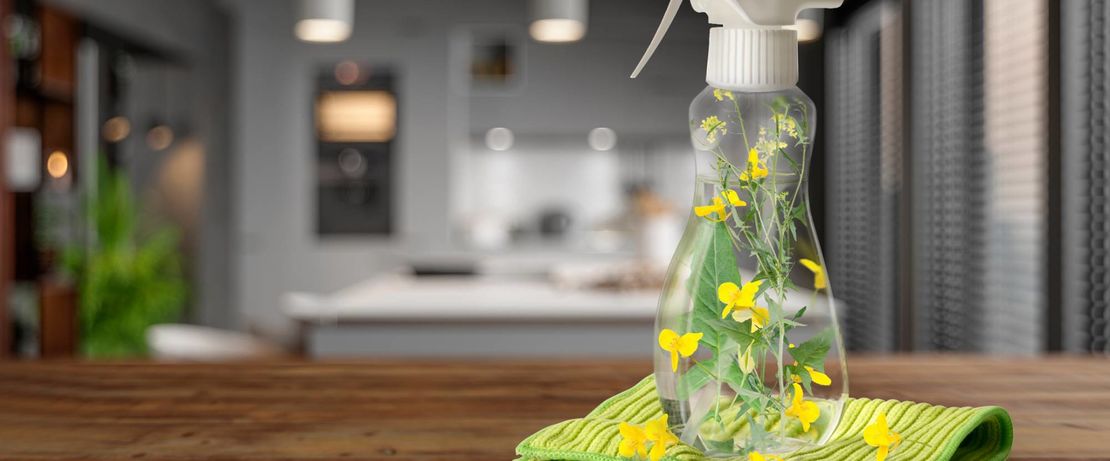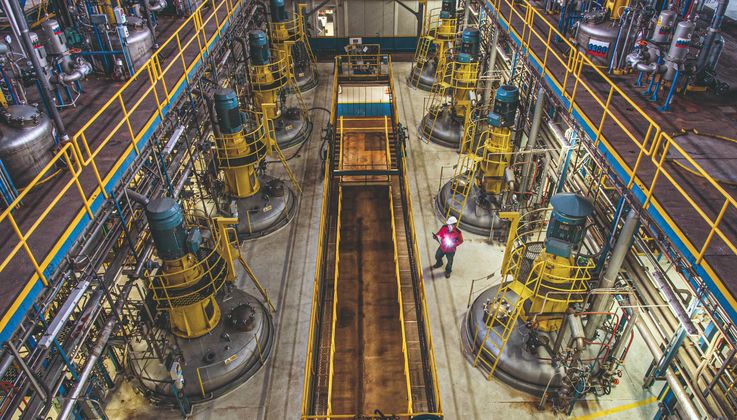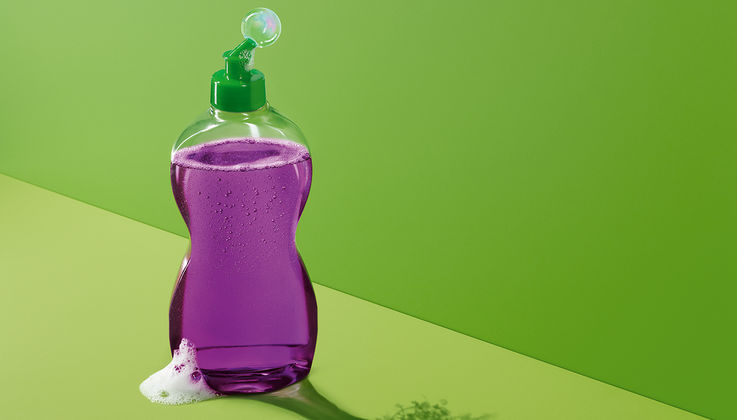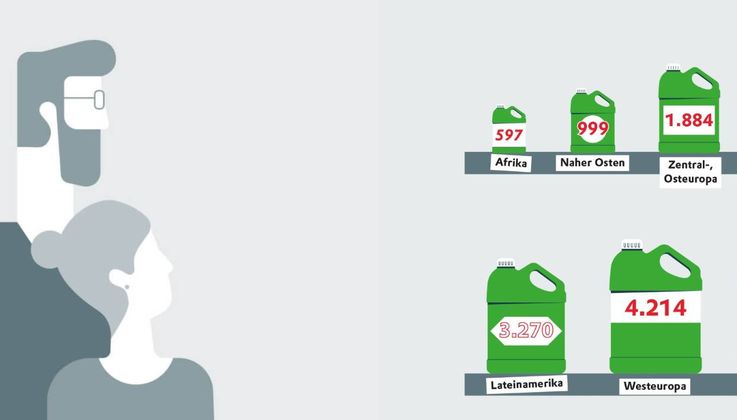

Bacterial surfactants making dishes cleaner
Rhamnolipids can change the market for cosmetics and detergents. These substances - produced by bacteria - are skin-friendly, rinse-active and very environmentally friendly. This latest innovation from Evonik is now proving its worth in a hand dishwashing detergent from a Dutch consumer goods company.
By Hans Henning Wenk, Head of Research and Development Care Solutions
Whoever invented it is hiding in the darkness of history: soap. The Old Testament mentioned it, the Sumerians used it and the Arabs brought it to Europe in the 7th century.
Some 1300 years later, at Evonik we have developed a technology that has the potential to fundamentally change the production of soap, or more precisely the production of surfactants as the most important component of detergents and cleaning agents.
The idea: We use the bacteria to produce the surfactants in a novel process. This not only conserves natural resources and is environmentally friendly; a dishwashing detergent produced on the basis of these bio-surfactants is also on a par with the best on the market in terms of its performance.
The performance of a detergent is measured by its "mileage". The term originates from the automotive industry and describes how far a vehicle can go with a certain amount of fuel.
In the laboratory, mileage refers to the number of dishes the testers can wash before the foam on the rinse water has disappeared. This is important because the sooner the foam collapses, the sooner the consumer changes the rinse water, because the consumer can read from the foam whether the rinse water can still remove grease and dirt. This means additional consumption of water, energy and detergent.
Surfactants are responsible for creating the foam. Depending on brand and type, they account for between five percent in standard dishwashing detergents and 30 percent in concentrates. They are decisive for efficiency and environmental friendliness. Effective surfactants are therefore an important factor in the sales success of a detergent. Bert Nijhuis of Unilever explains it this way: "If we want to make sustainability an integral part of our everyday lives, environmentally compatible products must deliver the same performance as conventional ones - or even better. "This is what Nijhuis, who heads research and development for hand and machine dishwashing detergents at consumer goods group Unilever from Rotterdam, believes is the recipe for market success.
But consumers now have other priorities besides the performance of a product. People are increasingly concerned that their cleaning products may have a negative impact on the environment," says Nijhuis, "which is why we make our high-performance products additionally environmentally friendly and skin-friendly. “
Until now, a surfactant that covers the aspects of performance, skin-friendliness and environmental compatibility equally well did not exist. The biosurfactants we have developed at Evonik are a groundbreaking step in household cleaning.
Basic information about surfactants
Surfactants work according to a simple principle: they have one end that "loves" water and one end that combines with fat. In this way, they ensure that the dissolved dirt does not end up on the dishes again. The new biosurfactant is based on so-called rhamnolipids. They consist of a water-insoluble lipid part and a water-soluble part, which is made up of the simple sugar rhamnose. These rhamnolipids decompose naturally - whether aerobically or anaerobically - to 100 percent natural substances. As a result, and this is the most important aspect, they are decisively more compatible for water organisms than other surfactants.
From soil bacteria
The starting point for the cleaner is a bacterium that prefers to stay in the dirt: Pseudomonas aeruginosa. It lives in the soil and feeds on among other things, on fats. The Silesian botanist Walter Migula first described these bacteria in 1900.
But it remained unnoticed for a long time for biotechnological use. One reason is that it is classified as pathogenic, which means that under unfavorable conditions it can potentially cause diseases such as pneumonia.
In the 1960s however, scientists discovered that the bacterium produces these rhamnolipids, albeit in small quantities. The idea of exploiting the purifying properties of these lipids therefore initially remained a vision. It was not until 2000, when it was possible to decode the bacterium's genome, that researchers took up this idea again.
Short outline of the soap history
The origin of soaps was a mixture of vegetable ash and oils. The Sumerians recognized about 5000 years ago that wounds treated with it healed better, the cleansing effect did not play a role at first, only the Romans took advantage of this. But even the Germanic tribes already had their own soaps. The Arabs then cooked lyes and oils in the 7th century and thus invented what we know today as soap. But soaps cannot cope with harder water and so synthetic surfactants based on petrochemical raw materials took their place in the industrial era.
But the first generation of these products caused foam mountains to form on wastewater and in rivers. The surfactants that were not broken down in water treatment, got into the environment and damaged organisms.
As a result, it was stipulated that surfactants in wastewater treatment plants must be degraded by at least 70 percent within four weeks. But as environmental awareness grew, consumers demanded more and wanted eco-dishwashing detergents.
Initially, consumers accepted that environmentally friendly products were less efficient than the standard, but those days are over. This is confirmed by Bert Nijhuis from the perspective of the global consumer goods group Unilever: "No matter what product we launch somewhere in the world, it has to perform - and for a dishwashing detergent, performance means above all that it makes dishes clean.”
In 2008, an Evonik research team started a project to develop a new generation of surfactants for cleaning and care products. We chose rhamnolipids because it was already clear that they have excellent foaming properties and are particularly biodegradable. In the further course of the project we were able to show that they also remove dirt just as reliably as synthetic surfactants, but are also characterized by excellent skin-friendliness.
My colleagues and I set out to find an alternative bacterium that could produce rhamnolipids without any health risk and that would allow a high yield. At the same time, plant-based sugars had to be the only raw material used, as they are available almost everywhere in the world from regional sources that do not compete with sensitive ecosystems. This was, of course, a bet for the future in terms of the financial and time involved.
Bacteria as producers
For the production we chose a bacterium that is already used as a recognized safety strain for various industrial applications. This strain was then programmed into the construction manual for the production of rhamnolipids. Step by step we succeeded in increasing the performance of the bacteria in such a way that a commercial use of the produced rhamnolipids seemed possible.
Breakthrough in Slovakia
At Unilever, too, research into cleaning agents based on rhamnolipids began early on. The business relationship with Evonik resulted in a joint development project in 2015, which quickly gained momentum with the availability of larger product volumes from our development activities. Unilever's research and development team had been familiar with rhamnolipids for years, explained Peter Ter Kulve, President of Unilever's London-based HomeCare business, in 2019 when the cooperation was presented, "but technology and science had not yet reached the point where industrial production was possible.”
Here, Evonik contributed its decades of experience with industrial fermentation processes. In 2016, the Slovakian plant in Slovenská Ľupča achieved a breakthrough in the large-scale production of rhamnolipids.
The biggest obstacle turned out to be what consumers particularly appreciate in detergent: the foam. The product should not foam during production.
The raw material used in the fermenters in Slovenská Ľupča is simple glucose. The conversion of this sugar to rhamnolipids is carried out by the bacterial strain in the fermenter at room temperature, which is energy-saving. In contrast to many synthetically produced surfactants, neither high temperatures nor hazardous substances are required for production.
Before the rhamnolipids can be used in the manufacture of cosmetic products and cleaning agents, they must be processed and concentrated. On the one hand, this serves to completely remove the microorganisms used for production, but also achieves the high-quality requirements, for example in terms of color and odor of the product. In addition, the concentration saves energy during transport and processing.
From cosmetics to detergent
At first we used rhamnolipids from Slovakia in the field of personal care products. With Rheance One, Evonik launched a product on the market for personal care products that won innovation awards and was very well received by the market.
Unilever had a different market in mind: hand dishwashing detergent. The Group pays particular attention to the sustainability of its products and the situation in emerging markets. There, the need for hygiene and cleanliness is increasing, while at the same time only a few households have a dishwasher. Hand dishwashing detergents are therefore in great demand. In addition, wastewater is often treated less intensively than in industrialized countries, so a completely degradable ingredient is a big advantage.
For the market launch, the experts at Unilever chose Chile and the very popular Quix brand. The most important sales argument was environmental compatibility, which Chileans attach great importance to when making purchasing decisions.
Unilever regards the market launch as such a great success that the group now wants to further intensify its cooperation with Evonik. The company sees cooperation with Evonik as one of the central pillars of its "Clean Future" initiative, which is designed to make the use of petrochemical raw materials in the Home Care Division obsolete by 2030 on the basis of renewable raw materials and recycling management.
A development that also fits in with Evonik's strategy of focusing on sustainability as a growth driver. We will continue to expand our portfolio of biotechnologically derived ingredients to further strengthen our position as a leading supplier of sustainable solutions that inspire customers and end consumers. For us, the story of soap is far from over.
This article was originally published in “Umweltmagazin”, issue 10-11, 2020.



